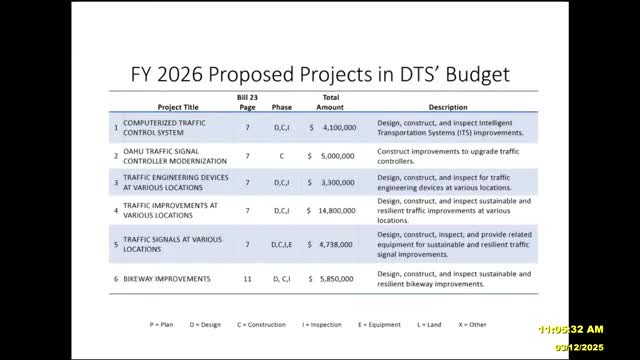City partners with State to modernize traffic signal system over four years
March 08, 2025 | Honolulu City, Honolulu County, Hawaii
This article was created by AI summarizing key points discussed. AI makes mistakes, so for full details and context, please refer to the video of the full meeting. Please report any errors so we can fix them. Report an error »

In the bustling chambers of Honolulu City Hall, city officials gathered to discuss a pivotal budget briefing that promises to reshape the island's transportation landscape over the next few years. The meeting, held on March 8, 2025, highlighted significant investments aimed at modernizing traffic systems and enhancing public transit, reflecting a commitment to improving the daily lives of residents.
One of the key topics was the ambitious plan to replace all traffic controllers across the island within the next four to five years. This initiative, a collaboration between the city and the State Department of Transportation, aims to unify the traffic signal systems that currently operate independently. With approximately 85% of traffic signals already connected, officials expressed optimism about completing the remaining connections, particularly in the Westside and Central areas.
The budget also earmarked $7.4 million for intermodal connectivity improvements, including the long-awaited Waipio Point Access Road project, which has faced delays but is now expected to move forward this year. Additionally, a substantial $75 million is allocated for the acquisition of new buses and handy vans, ensuring that public transportation remains accessible and efficient. Improvements to bus stops, particularly those enhancing ADA compliance, were also emphasized, showcasing a commitment to inclusivity.
The discussion extended to the Middle Street Transit Center, where plans for a new electric bus charging station were unveiled, signaling a shift towards sustainable transportation solutions. The Department of Design and Construction is set to play a crucial role in electrifying transportation infrastructure, with ongoing projects in Alipay and Pearl City.
As the meeting progressed, council members raised questions about the prioritization of traffic light upgrades and the integration of traffic cameras into the new systems. Officials assured them that a strategic timeline is in place, with a focus on areas that have not yet been fully connected to the traffic signal network.
Concerns were also voiced regarding the future of the Safe Routes to School program, which has historically relied on federal funding. While current funding is stable, officials acknowledged the uncertainty surrounding future allocations. Nevertheless, they reaffirmed their commitment to ensuring safe pathways for children traveling to school, emphasizing collaboration with council members to implement necessary programs.
As the meeting concluded, the atmosphere was one of cautious optimism. The proposed budget reflects a proactive approach to addressing the transportation needs of Honolulu, with a clear vision for a more connected and efficient future. Residents can look forward to seeing these plans unfold, transforming their daily commutes and enhancing the overall quality of life on the island.
One of the key topics was the ambitious plan to replace all traffic controllers across the island within the next four to five years. This initiative, a collaboration between the city and the State Department of Transportation, aims to unify the traffic signal systems that currently operate independently. With approximately 85% of traffic signals already connected, officials expressed optimism about completing the remaining connections, particularly in the Westside and Central areas.
The budget also earmarked $7.4 million for intermodal connectivity improvements, including the long-awaited Waipio Point Access Road project, which has faced delays but is now expected to move forward this year. Additionally, a substantial $75 million is allocated for the acquisition of new buses and handy vans, ensuring that public transportation remains accessible and efficient. Improvements to bus stops, particularly those enhancing ADA compliance, were also emphasized, showcasing a commitment to inclusivity.
The discussion extended to the Middle Street Transit Center, where plans for a new electric bus charging station were unveiled, signaling a shift towards sustainable transportation solutions. The Department of Design and Construction is set to play a crucial role in electrifying transportation infrastructure, with ongoing projects in Alipay and Pearl City.
As the meeting progressed, council members raised questions about the prioritization of traffic light upgrades and the integration of traffic cameras into the new systems. Officials assured them that a strategic timeline is in place, with a focus on areas that have not yet been fully connected to the traffic signal network.
Concerns were also voiced regarding the future of the Safe Routes to School program, which has historically relied on federal funding. While current funding is stable, officials acknowledged the uncertainty surrounding future allocations. Nevertheless, they reaffirmed their commitment to ensuring safe pathways for children traveling to school, emphasizing collaboration with council members to implement necessary programs.
As the meeting concluded, the atmosphere was one of cautious optimism. The proposed budget reflects a proactive approach to addressing the transportation needs of Honolulu, with a clear vision for a more connected and efficient future. Residents can look forward to seeing these plans unfold, transforming their daily commutes and enhancing the overall quality of life on the island.
View full meeting
This article is based on a recent meeting—watch the full video and explore the complete transcript for deeper insights into the discussion.
View full meeting
